radiator GMC JIMMY 1997 Owner's Manual
[x] Cancel search | Manufacturer: GMC, Model Year: 1997, Model line: JIMMY, Model: GMC JIMMY 1997Pages: 410, PDF Size: 20.03 MB
Page 235 of 410
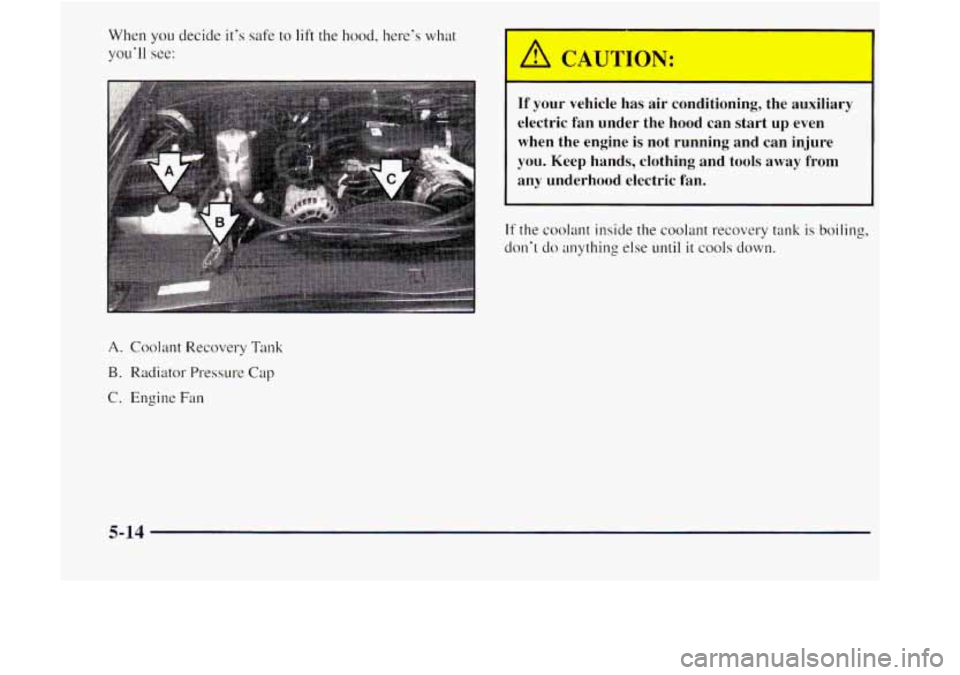
When you decide it's safe to lift the hood. here's what
you'll see:
A. Coolant Recovery Tank
B. Radiator Pressure Cap
C. Engine Fan
A CAUTION:
r
If your vehicle has air conditioning, the auxiliary
electric fan under the hood can start
up even
when the engine is not running and can injure
you. Keep hands, clothing and tools away
from
any underhood electric fan.
If the coolant inside the coolant recovery tank is boiling,
don't
do anything else until it cools down.
5-14
Page 236 of 410

Heater and radiator hoses, and other engine
parts, can be very hot. Don't touch them.
If' you
do, you can be burned.
Don't run the engine
if there is a leak. If' you run
the engine, it could lose all coolant. That
could
cause an engine fire, and you could be burned.
Get any leak fixed before
you drive the vehicle.
I NOTICE:
Engine damage from running your engine
without coolant isn't
covered by your warranty.
If there seems to be 110 leak, start the engine again. See
if the t'an speed increases when idle speed is doubled by
pushing the accelerator pedal
down. If it doesn't. your
vehicle needs service. T~1l-11
off the engine.
Page 237 of 410
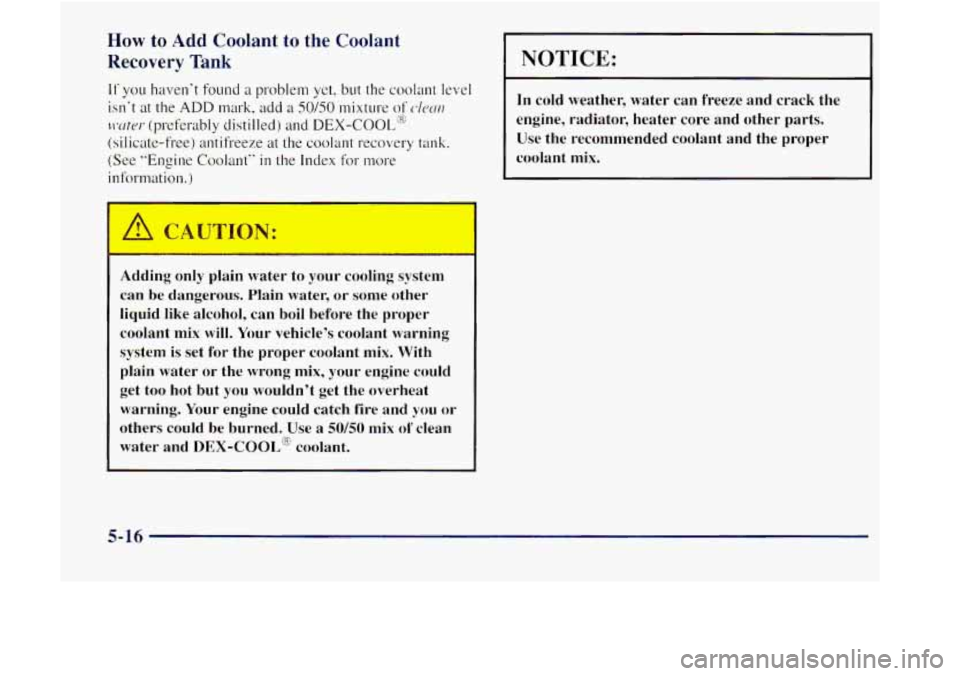
How to Add Coolant to the Coolant
Recovery Tank
If you haven't found a problem yet, but the coolant level
isn't at the
ADD mark, add a SO/SO mixture of d~ctrz
,twtur (preferably distilled) and DEX-COOL'@
(silicate-free) antifreeze at the coolant recovery tank.
(See "Engine Coolant" in the Index for more
information.
)
_s I
Adding only plain water to your cooling system
can be dangerous. Plain water, or some other
liquid like alcohol, can boil before the proper
coolant mix
will. Your vehicle's coolant warning
system is set for the proper coolant mix. With
plain water or the wrong mix, your engine could
get too hot but you wouldn't get the overheat
warning. Your engine could catch fire and you or
others could be burned. Use
a 50/50 mix of clean
water and
DEX-COOL" coolant.
NOTICE:
In cold weather, water can freeze and crack the
engine, radiator, heater core and other parts. Use the recommended coolant and the proper
coolant mix.
5-16
Page 239 of 410

I
& 't 'IUTION:
Steam and scalding liquids from a hot cooling
system can blow out and burn you badly. They
are under pressure, and
if you turn the radiator
pressure cap
=- even a little == they can come out
at high speed. Never turn the cap when the
cooling system, including the radiator pressure
cap, is hot. Wait for the cooling system and
radiator pressure cap to cool
if you ever have to
turn the pressure cap.
5-18
Page 240 of 410

How to Add Coolant to the Radiator
5- 19
Page 271 of 410
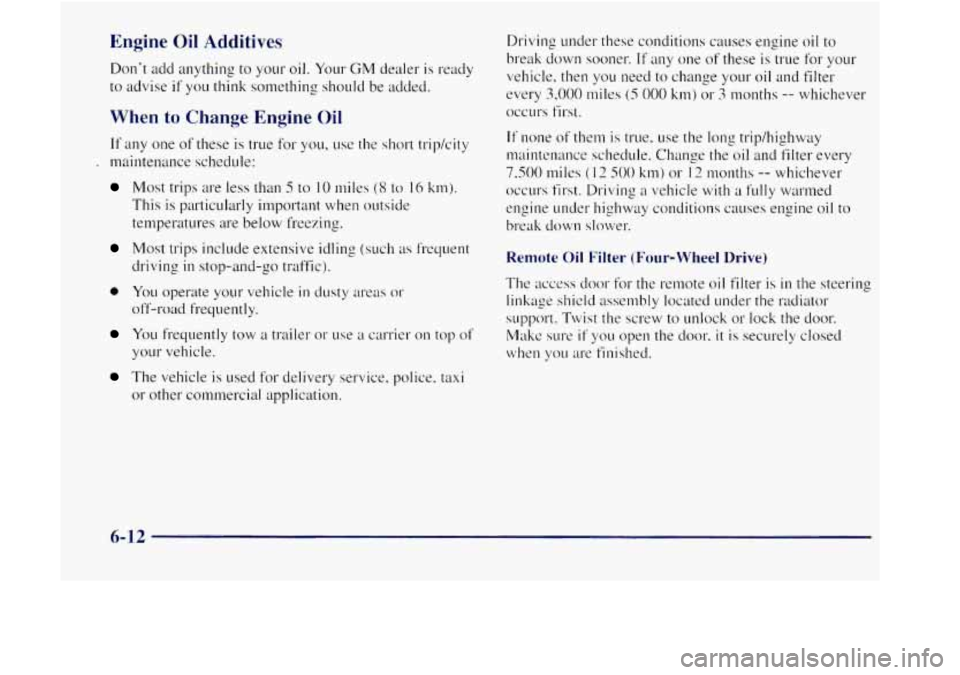
Engine Oil Additives
Don't add anything to your oil. YOLK GM dealer is ready
to advise
if you think something should be added.
When to Change Engine Oil
If any one of these is true for you. LIS~ the short trip/city
. maintenxm schedule:
Most trips are less than 5 to 10 miles (8 to 16 km).
This is particularly important when outside
temperatures are below freezing.
Most trips include extensive idling (such as frequent
driving
in stop-and-go traffic).
0 You operate your vehicle in dusty areas or
off-road frequently.
YOLI frequently tow a trailer or use a carrier on top of
your vehicle.
The vehicle is used for delivery service, police, taxi
or other commercial application. Driving under
these conditions causes engine oil to
break
down sooner. If any one of these is true for your
vehicle. then you need to change your
oil and filter
every
3.000 miles (5 000 km) or 3 months -- whichever
occurs first.
Remote Oil Filter (Four-wheel Drive)
The ;1ccess door for the remote oil filter is in the steering
linkage shicld
assembly located under the radiator
support. Twist the
screw to unlock or lock the door.
Make sure
if you open the door, it is securely closed
when you are finished.
6-12
Page 282 of 410
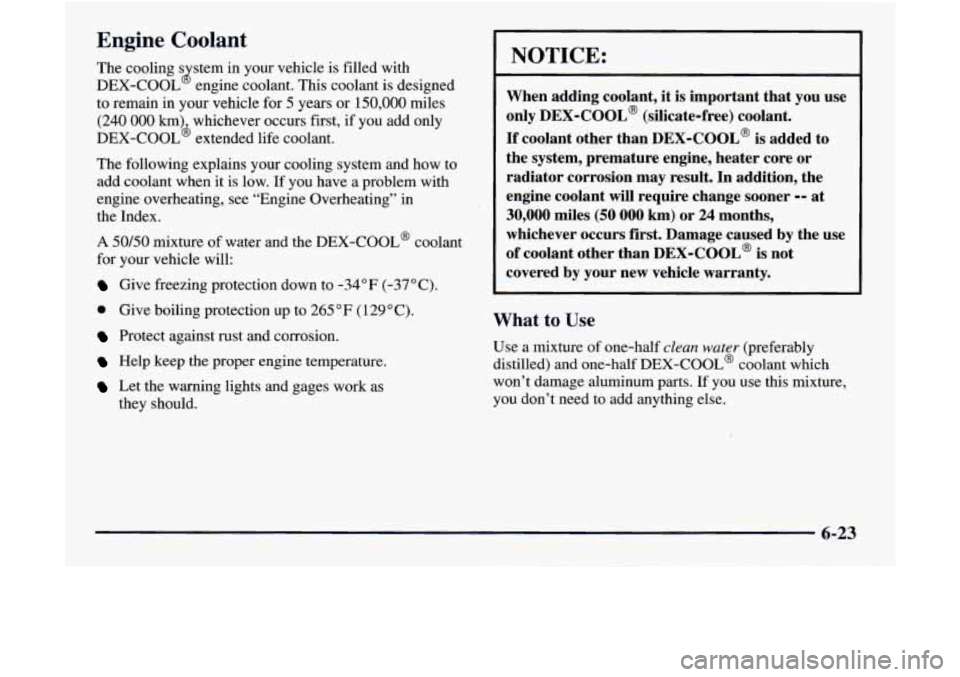
Engine Coolant
The cooling s stem in your vehicle is filled with
DEX-COOL engine coolant. This coolant is designed
to remain in your vehicle
for 5 years or 150,000 miles
(240 000 km) whichever occurs first, if you add only
DEX-COOL’ extended life coolant.
The following explains your cooling system and how to
add coolant when it is low. If you have a problem with
engine overheating, see “Engine Overheating” in
the Index.
A 50/50 mixture of water and the DEX-COOL@ coolant
for your vehicle will:
Give freezing protection down to -34°F (-37°C).
0 Give boiling protection up to 265 OF ( 129 O C).
Protect against rust and corrosion.
Help keep the proper engine temperature.
Let the warning lights and gages work as
8
they should.
NOTICE:
When .adding coolant, it is important that you use
only
DEX-COOL@ (silicate-free) coolant.
If coolant other than DEX-COOL@ is added to
the system, premature engine, heater core
or
radiator corrosion may result. In addition, the
engine coolant will require change sooner
-- at
30,000 miles (50 000 km) or 24 months,
whichever occurs
first. Damage caused by the use
of coolant other than DEX-COOL@ is not
covered by your new vehicle warranty.
What to Use
Use a mixture of one-half clean water (preferably
distilled) and one-half DEX-COOL@ coolant which
won’t damage aluminum parts. If you use this mixture,
you don’t need to add anything else.
6-23
Page 283 of 410
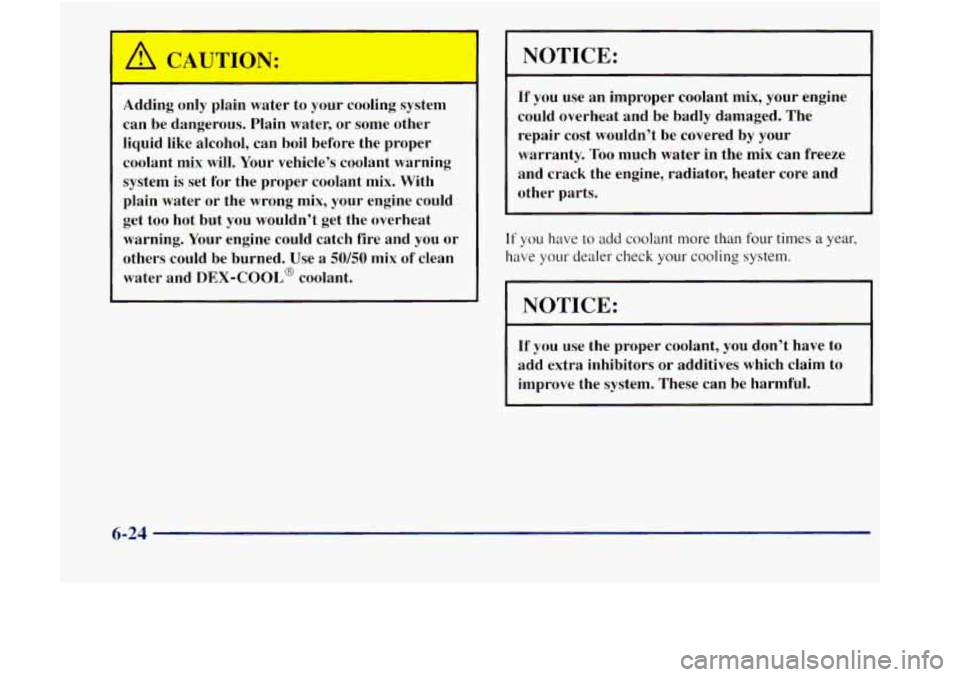
Adding only plain water to your cooling system can be dangerous. Plain water, or some other
liquid like alcohol, can boil before the proper
coolant mix will. Your vehicle’s coolant warning
system
is set for the proper coolant mix. With
plain water or the wrong mix, your engine could
get too hot but you wouldn’t get the overheat warning. Your engine could catch fire and you or
others could be burned. Use a
50/50 mix of clean
water and
DEX-COOL@ coolant.
NOTICE:
If you use an improper coolant mix, your engine
could overheat and be badly damaged. The
repair cost wouldn’t be covered by your
warranty.
Too much water in the mix can freeze
and crack the engine, radiator, heater core and
other parts.
If you have to add coolant more than four times a year,
have your dealer check your cooling
system.
I NOTICE:
If you use the proper coolant, you don’t have to
add extra inhibitors or additives which claim to improve the system. These can be harmful.
6-24
Page 284 of 410

Checking Coolant
When your engine is cold. the coolant level should be at
ADD, or a little higher. When your engine is warm. the
level
should be up to FULL HOT, or a little higher.
Adding Coolant
If you need more coolant, add the proper DEX-COOL'
coolant mixture crt rhe cwolcrllt I-KO\!PI-J tcrnk.
~ ' Turning the radiator pressure cap when the
engine and radiator are hot can allow steam and
scalding liquids to blow out and burn
you badly.
With the coolant recovery tank,
you will almost
never have to add coolant at the radiator.
Never turn the radiator pressure cap
-- even a
little
-- when the engine and radiator are hot.
Add DEX-COOL@ coolant mixture at the recovery
tank, but be careful not to spill
it.
You can be burned if you spill coolant on hot
engine parts. Coolant contains ethylene glycol,
and it will burn
if the engine parts are hot
enough. Don't
spill coolant on a hot engine.
6-25
Page 285 of 410
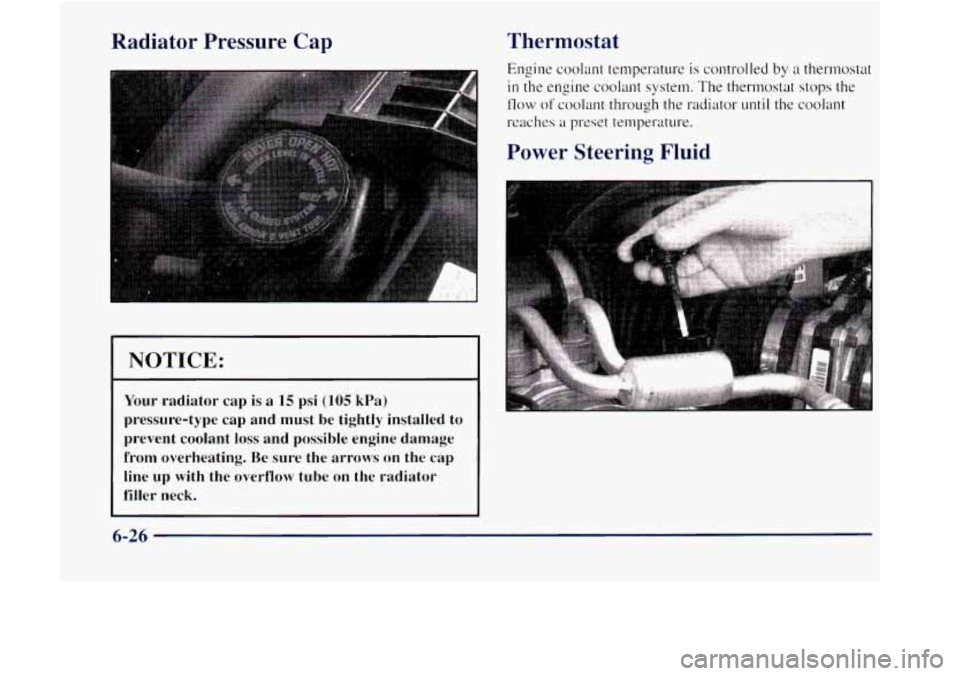
Radiator Pressure Cap
NOTICE:
Your radiator cap is a 15 psi (105 kPa)
pressure-type cap and must be tightly installed to
prevent coolant
loss and possible engine damage
fronl overheating. Be sure the arrows
on the cap
line up with the overflow tube on the radiator
filler neck.
Thermostat
Engine coolant temperattrre is controlled by a thermostat
in the engine coolant system. The thermostat stops the
flow of coolant through the radiator until the coolant
reaches
a preset temperature.
Power Steerinp Fluid
6-26